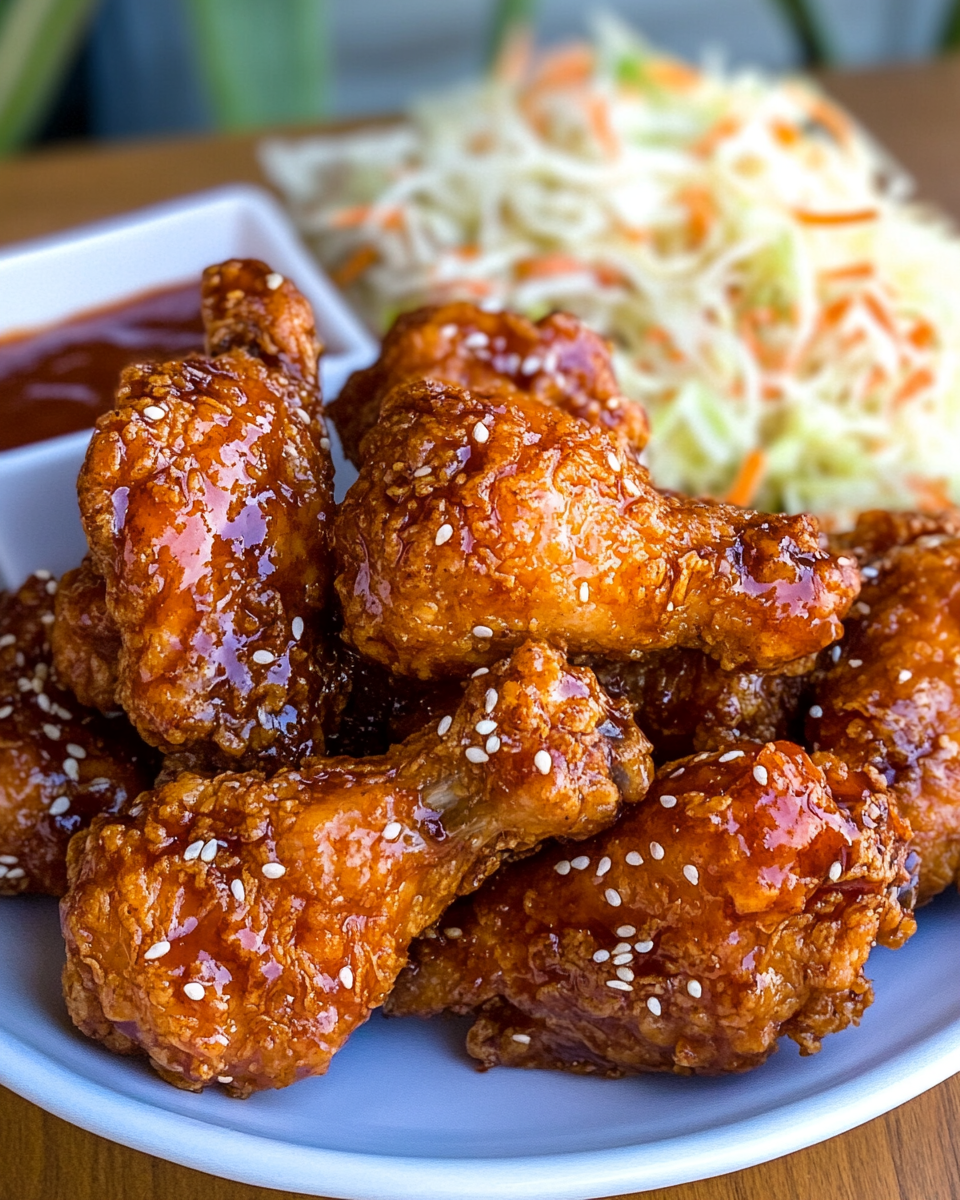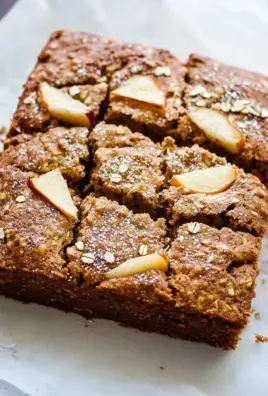Korean Fried Chicken, known as Yangnyeom Chicken, is an iconic dish from South Korea that has captivated food lovers around the world. What sets it apart from traditional fried chicken is its ultra-crispy double-fried exterior and its flavorful coating—a bold, sweet, and spicy sauce made with gochujang, a fermented Korean chili paste. The result is chicken that’s tender and juicy on the inside, with a shatteringly crisp crust and a sticky, vibrant glaze that hits all the right flavor notes.
Perfect for game day, casual gatherings, or when you’re simply craving Korean takeout at home, this dish is easy to make and incredibly satisfying. Whether served with classic Korean side dishes or as the centerpiece of a shared meal, Yangnyeom Chicken delivers on both taste and texture.

Why You’ll Love This Recipe
- Double-fried for maximum crunch and crispness
- Coated in a rich gochujang sauce that’s sweet, spicy, and savory
- Perfect as a main course, appetizer, or party snack
- Made with pantry staples and accessible ingredients
- Easily adjustable spice levels to suit any palate
This recipe not only tastes authentic but is also customizable and accessible for home cooks.
Preparation Phase
To get the best results, preparation is essential. Seasoning the chicken in advance and using the proper battering technique will help you achieve the signature crispy texture and bold flavor.
Essential Tools and Equipment
- Heavy-bottomed pot or Dutch oven
- Deep-fry thermometer
- Mixing bowls for batter and seasoning
- Tongs and wire rack
- Saucepan for cooking the sauce
Importance of Each Tool
A heavy-bottomed pot ensures even heat distribution for frying. A thermometer is critical to maintain accurate oil temperature, which affects texture. A wire rack allows the chicken to cool without steaming, keeping the crust crisp. Proper tools streamline the process and contribute to better results.
Preparation Tips
- Pat chicken completely dry before seasoning and battering to help the crust adhere and reduce oil splatter.
- Dry brine the chicken with salt and spices overnight or for at least an hour at room temperature. This deepens flavor and draws out moisture.
- Keep your wet batter cold. Using cold club soda creates air pockets during frying, enhancing crispiness.
- Avoid overcrowding the pan during frying, which can lower the oil temperature and result in soggy chicken.
Ingredients
For the Chicken:
- 2 lbs chicken wings and drumettes (about 16 pieces)
- Peanut oil (or canola/vegetable oil), for frying
- 1 tsp sesame seeds, for garnish
Chicken Seasoning:
- 1½ tsp salt
- 1 tsp garlic powder
- ½ tsp black pepper
- 1 tbsp cayenne pepper (optional)
Dry Batter:
- ½ cup potato starch
- ¼ cup all-purpose flour
- 1 tsp chicken bouillon powder
- 1 tsp salt
- 1 tbsp cayenne pepper (optional)
Wet Batter:
- ½ cup potato starch
- ¼ cup all-purpose flour
- 1 egg
- 1 tsp baking powder
- ½ cup cold club soda (or cold water)
Yangnyeom Sauce:
- ¼ cup ketchup
- ¼ cup extra spicy gochujang
- ¼ cup rice syrup
- ¼ cup water
- 3 tbsp soy sauce
- 3 tbsp sugar
- 2 tsp plum vinegar (or rice/white vinegar)
- 1 tsp gochugaru (Korean chili flakes)
- 1 tbsp neutral oil
- 3 garlic cloves, minced
Step-by-Step Instructions
1. Season the Chicken
Pat the chicken dry using paper towels. Mix salt, garlic powder, black pepper, and cayenne. Rub the seasoning over the chicken thoroughly. Dry brine uncovered in the refrigerator overnight or let sit at room temperature for one hour.
2. Make the Yangnyeom Sauce
In a small saucepan over medium-low heat, sauté minced garlic in oil until fragrant but not browned. Add ketchup, gochujang, rice syrup, water, soy sauce, sugar, vinegar, and gochugaru. Simmer gently for 2 to 3 minutes. Stir well and set aside.
3. Prepare the Batters
In one bowl, mix the dry batter ingredients. In another bowl, whisk together the wet batter ingredients until smooth. Keep the wet batter cold until ready to use.
4. Coat the Chicken
Dip each piece of seasoned chicken into the wet batter, allowing the excess to drip off. Press it into the dry batter to coat fully. Shake off excess before frying.
5. First Fry
Heat oil in a deep pot to 350°F. Fry the chicken in batches for 6 to 7 minutes (or 7 to 8 minutes for larger pieces). Maintain oil temperature between 320°F and 335°F. Transfer to a wire rack to rest.
6. Second Fry
Reheat oil to 370°F. Fry the chicken again for 1 minute per batch. This step ensures maximum crunch and removes excess moisture.
7. Sauce and Serve
Toss the hot, double-fried chicken in the prepared yangnyeom sauce or brush it on each piece. Garnish with toasted sesame seeds and serve immediately.
Serving Suggestions
Serve Yangnyeom Chicken immediately after tossing in the sauce. The crisp texture is at its peak right out of the fryer. Let the chicken cool slightly for 1 to 2 minutes before adding the sauce to prevent the heat from softening the crust.
Here are some ways to serve Korean Fried Chicken for a complete dining experience:
- Traditional Korean-style: Serve with cubes of pickled Korean radish (chikin-mu) to refresh the palate between bites.
- Rice pairing: White steamed rice is a classic, neutral side that balances the richness and spice.
- Korean-style slaw: A cabbage slaw with sesame or soy dressing adds freshness and crunch.
- Casual dinner: Plate with fresh vegetables and lettuce wraps for a build-your-own option.
- Party platter: Serve with a variety of dipping sauces like garlic mayo, soy-sesame glaze, or extra gochujang sauce for guests to enjoy.
Korean Fried Chicken is incredibly versatile and works well as a main course, shared appetizer, or part of a larger Korean meal.
Eight Side Dish Recommendations
Side dishes provide contrast in texture, temperature, and flavor. These options pair especially well with the sweet, spicy, and savory notes of Yangnyeom Chicken.
1. Pickled Korean Radish (Chikin-mu)
Crisp, tangy, and slightly sweet, this pickled radish is traditionally served with Korean fried chicken. It cuts through the richness and enhances the chicken’s flavor.
2. Kimchi
Spicy and fermented, kimchi adds depth to the meal. Its acidic, umami-rich profile complements the bold yangnyeom sauce.
3. Steamed White Rice
A simple bowl of steamed short-grain rice balances the heat and sweetness of the chicken while allowing the flavors to stand out.
4. Japchae (Korean Glass Noodles)
Sweet potato starch noodles stir-fried with vegetables and soy sauce offer a soft, savory balance to the crisp chicken.
5. Korean Potato Salad
This creamy and slightly sweet potato salad often includes apples, cucumbers, or carrots. It provides a cooling contrast to the spicy chicken.
6. Cabbage Slaw with Sesame Dressing
Shredded cabbage tossed in a light sesame-soy vinaigrette adds freshness and a slight nuttiness that complements the deep-fried chicken.
7. Tteokbokki (Spicy Rice Cakes)
Chewy rice cakes cooked in gochujang sauce pair beautifully with the chicken’s flavor profile and texture.
8. Korean Corn Cheese
A hot, cheesy corn side dish made with mozzarella and mayo. It is creamy, rich, and slightly sweet, balancing the spicy heat of the chicken.
Combining two or three of these dishes creates a full, satisfying Korean meal. They are easy to prepare or source and are popular in both traditional and modern Korean dining.
Common Mistakes to Avoid
Even with a strong recipe, small mistakes can affect the outcome of your Korean Fried Chicken. Here are common errors and how to avoid them.
Skipping the Dry Brine
Dry brining—seasoning the chicken and letting it sit uncovered—improves both flavor and texture. Skipping this step often leads to bland, underseasoned meat and less crisp skin.
Not Drying the Chicken Properly
Moisture prevents the batter from adhering and causes dangerous oil splatter. Always pat your chicken thoroughly dry with paper towels before seasoning and battering.
Overcrowding the Frying Pot
Adding too many pieces at once lowers the oil temperature, resulting in greasy, soggy chicken. Fry in small batches and allow the oil to return to proper temperature between rounds.
Ignoring Oil Temperature
Consistent oil temperature is critical. For the first fry, keep the oil between 320°F and 335°F. For the second fry, heat it to 370°F. Use a deep-fry thermometer to monitor accurately.
Using Room Temperature Batter
A cold wet batter made with chilled club soda produces a crisp, airy crust. If the batter is too warm, the coating becomes heavy and oily.
Only Frying Once
The signature crunch of Korean Fried Chicken comes from double frying. The first fry cooks the chicken through, and the second removes excess moisture and oil, ensuring crispness.
Tossing in Sauce Too Early
Tossing the chicken in sauce right after frying can steam the crust. Let the chicken rest for a couple of minutes, then toss or brush with sauce to preserve crispness.
Using Poor-Quality Gochujang
The quality of gochujang directly impacts the flavor of the sauce. Choose brands that use traditional fermentation methods and avoid those with excessive sugar or artificial flavors.
By avoiding these mistakes and paying attention to technique, you’ll consistently produce restaurant-quality Korean Fried Chicken at home.
Recipe Tips and Variations
Even though this recipe produces excellent results as written, small adjustments can customize the flavor or make the process easier.
Use boneless chicken
Boneless thighs or breast pieces work well if you prefer a cleaner eating experience. Adjust cooking time accordingly—smaller pieces cook faster.
Adjust spice level
Gochujang and gochugaru vary in heat. Use less gochujang or add a touch of honey to mellow the sauce. For extra heat, increase the amount of gochugaru or cayenne.
Make extra sauce
Double the Yangnyeom sauce recipe and store the remainder in the fridge. It pairs well with rice, noodles, tofu, and roasted vegetables.
Try rice flour
To make the recipe gluten-free, substitute all-purpose flour with rice flour in both batters. Check that your gochujang is also gluten-free.
Air-fry variation
While not traditional, you can adapt this recipe for an air fryer. Cook battered chicken at 375°F for 20 to 25 minutes, flipping halfway, then apply sauce just before serving.
Toppings and garnish
Enhance presentation and flavor with chopped green onions, crushed peanuts, or a sprinkle of furikake seasoning.
These small tweaks allow the dish to suit a variety of diets and occasions without sacrificing its signature bold taste and crispy texture.
Storage and Reheating Instructions
Refrigeration
Store leftover fried chicken in an airtight container in the refrigerator for up to three days. For best results, store the chicken and sauce separately. This helps preserve the crisp texture.
Freezing
You can freeze fried chicken after the first fry. Let the pieces cool completely, then store in a freezer-safe container with parchment paper between layers. Freeze for up to one month. Fry directly from frozen for the second fry.
Reheating
The best way to reheat Korean Fried Chicken is to use an oven or air fryer.
Oven method:
- Preheat oven to 400°F.
- Place chicken on a wire rack over a baking sheet.
- Reheat for 8 to 10 minutes until hot and crispy.
Air fryer method:
- Preheat air fryer to 375°F.
- Cook chicken for 5 to 7 minutes until reheated and crisp.
Avoid using the microwave. It softens the crust and affects the quality of the sauce.
Frequently Asked Questions
What is Yangnyeom Chicken?
Yangnyeom Chicken is Korean-style fried chicken tossed in a sweet, spicy, and savory sauce made with gochujang, garlic, sugar, and soy sauce.
What makes Korean fried chicken different?
The double-frying technique, thin batter, and gochujang-based sauce distinguish it from American fried chicken. The result is extra crispy texture and bold flavor.
Can I make it less spicy?
Yes. Use mild gochujang and reduce or omit gochugaru. You can also add a spoonful of honey or ketchup to balance the spice.
Can I use boneless chicken?
Boneless chicken thighs or breasts are excellent options. Cut into bite-sized pieces and reduce frying time slightly.
Is this recipe gluten-free?
Not as written, but you can make it gluten-free by using rice flour instead of all-purpose flour and ensuring the gochujang and soy sauce are gluten-free.
Can I bake instead of fry?
Baking won’t deliver the same crispiness, but it is possible. Bake coated chicken on a wire rack at 425°F for 25 to 30 minutes, flipping halfway through. Use convection if available.
How do I keep the chicken crispy?
Fry in small batches, maintain oil temperature, and avoid adding sauce too early. Serve immediately after saucing for best texture.
What oil should I use for frying?
Use a neutral, high-smoke point oil such as peanut, canola, or vegetable oil. Avoid olive oil or butter.
Can I make the sauce ahead of time?
Yes. Prepare the Yangnyeom sauce up to five days in advance. Store it in an airtight container in the refrigerator and reheat gently before using.
What are good substitutes for gochujang?
While there is no perfect substitute, a mix of miso paste and chili paste or sriracha can work in a pinch. However, for authentic flavor, use real gochujang.
Conclusion
Korean Fried Chicken (Yangnyeom Chicken) is more than just a trendy dish—it’s a masterclass in balance, texture, and flavor. The crispy, golden crust created by double frying, combined with the sticky, spicy-sweet gochujang sauce, makes for an unforgettable eating experience.
With the proper preparation, the right tools, and a few key techniques, you can bring restaurant-quality Korean fried chicken into your own kitchen. Whether you’re serving it at a party, enjoying it with family, or saving it for leftovers, this recipe delivers every time.
For more Korean recipes and complementary side dishes, explore our collection of Korean comfort foods like Kimchi Fried Rice, Tteokbokki, or Japchae to complete your homemade Korean meal.
Korean Fried Chicken (Yangnyeom Chicken)
Ingredients
For the Chicken:
- 2 lbs chicken wings and drumettes about 16 pieces
- Peanut oil or canola/vegetable oil, for frying
- 1 tsp sesame seeds for garnish
Chicken Seasoning:
- 1½ tsp salt
- 1 tsp garlic powder
- ½ tsp black pepper
- 1 tbsp cayenne pepper optional, for extra heat
Dry Batter:
- ½ cup potato starch
- ¼ cup all-purpose flour
- 1 tsp chicken bouillon
- 1 tsp salt
- 1 tbsp cayenne pepper optional
Wet Batter:
- ½ cup potato starch
- ¼ cup all-purpose flour
- 1 egg
- 1 tsp baking powder
- ½ cup cold club soda or cold water
Yangnyeom Sauce:
- ¼ cup ketchup
- ¼ cup extra spicy gochujang
- ¼ cup rice syrup
- ¼ cup water
- 3 tbsp soy sauce
- 3 tbsp sugar
- 2 tsp plum vinegar or rice/white vinegar
- 1 tsp gochugaru Korean red chili flakes
- 1 tbsp neutral oil
- 3 garlic cloves minced
Instructions
Season the Chicken
- Pat the chicken dry with paper towels. Mix together the salt, garlic powder, black pepper, and optional cayenne. Rub the seasoning all over the chicken. Let it dry brine uncovered in the fridge overnight, or let it sit at room temperature for 1 hour.
- Make the Yangnyeom Sauce
- In a small saucepan over medium-low heat, sauté minced garlic in oil until fragrant (do not brown). Add all remaining sauce ingredients. Let the mixture bubble gently for 2–3 minutes, stirring occasionally. Remove from heat and set aside. You can make this ahead and refrigerate.
Prepare the Batters
- For the dry batter: Combine potato starch, flour, bouillon, salt, and cayenne.
- For the wet batter: Whisk together potato starch, flour, egg, baking powder, and cold club soda until smooth.
Coat the Chicken
- Dip each piece of chicken into the wet batter, letting excess drip off. Then press it into the dry batter, ensuring full coverage. Tap off any excess.
- First Fry
- Heat oil in a deep pot to 350°F. Fry chicken in batches (do not overcrowd) for 6–7 minutes, or 7–8 minutes for larger pieces. Keep the oil temperature between 320–335°F. Transfer fried chicken to a wire rack to rest.
Second Fry
- Reheat oil to 370°F. Fry the chicken again for 1 minute per batch, keeping oil above 350°F. This second fry adds extra crunch.
Sauce & Finish
- Toss hot chicken pieces in the prepared Yangnyeom sauce, or brush sauce over each piece for even coating. Garnish with toasted sesame seeds.
Serve
- Serve immediately with pickled radish, cabbage slaw, and a cold beer for the full Korean fried chicken experience.




Leave a Comment